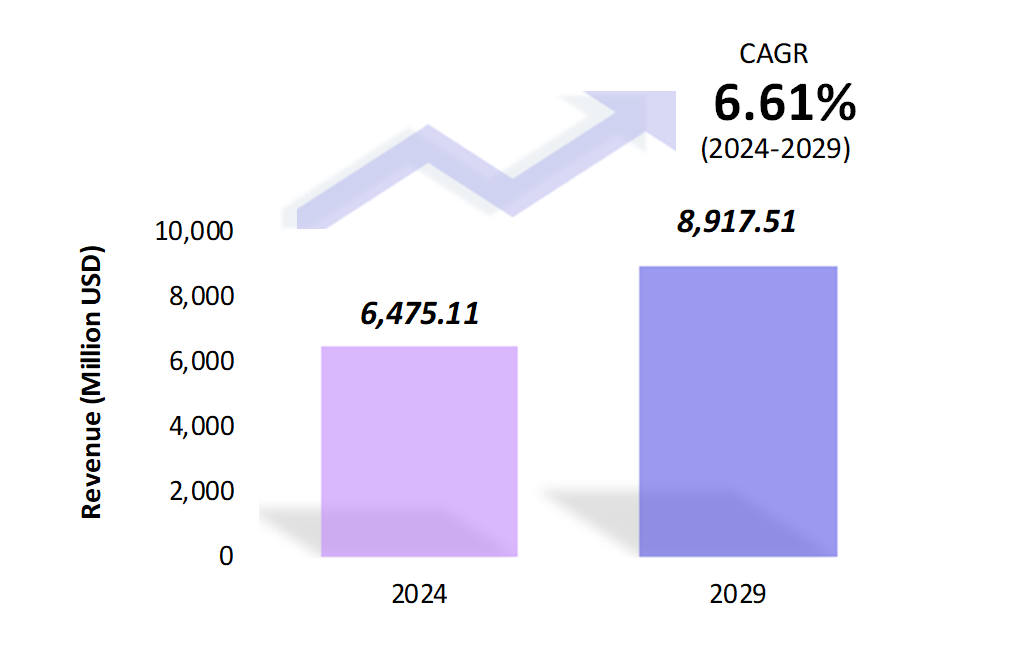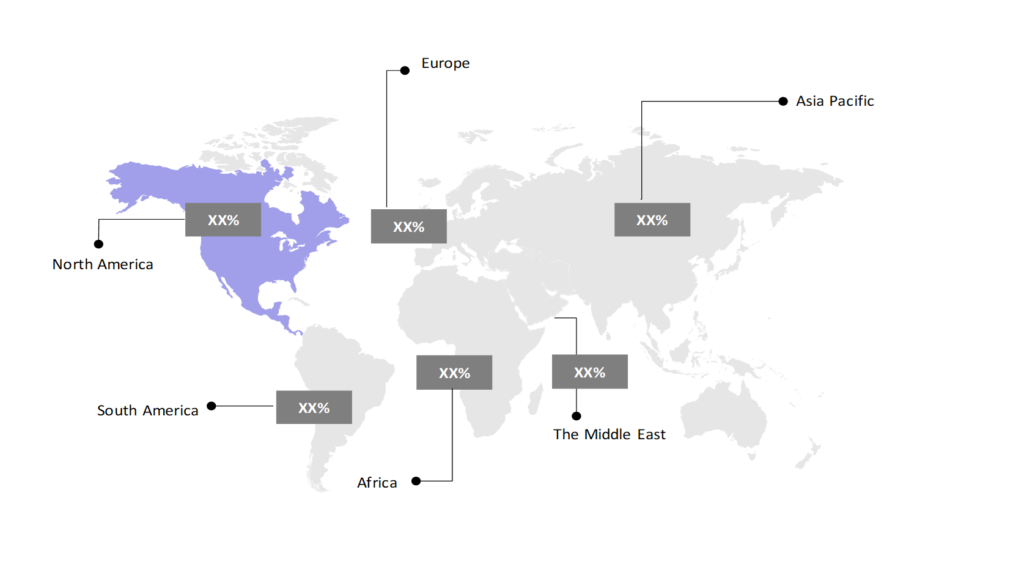Aerospace Foam Market: Size, Share, Trends & Forecast (2024-2029)
The market report presents a thorough analysis segmented by Type (Polyurethane, Polyimide, Metal Foams, Melamine, Polyethylene, Others); by Application (Commercial Aviation, Military Aviation, Business and General Aviation); by Geography (North America, South America, Asia Pacific, Europe, The Middle East, Africa).
Outlook

- The aerospace foam market is estimated to be at USD 6,475.11 Mn in 2024 and is anticipated to reach USD 8,917.51 Mn in 2029.
- The aerospace foam market is registering a CAGR of 6.61% during the forecast period 2024-2029.
- The global aerospace foam market is experiencing steady growth due to increasing demand in both commercial and defense aviation sectors. Aerospace foams are essential for providing lightweight, high-strength materials for seating, insulation, and structural components.
Request a free sample.
Ecosystem

- The global aerospace foam industry participants are always developing strategies to preserve a competitive advantage.
- These companies focus on acquisitions and partnerships, providing custom, advanced, flexible, and high-performance foam solutions designed for aircraft seating and cabin interiors, meeting the growing demand for eco-friendly materials.
- Several important entities in the aerospace foam market include BASF Group; Rogers Corp; Evonik Industries AG; Solvay Group; Greiner AG; and others.
Ask for customization.
Findings
| Attributes | Values |
|---|---|
| Historical Period | 2018-2022 |
| Base Year | 2023 |
| Forecast Period | 2024-2029 |
| Market Size (2024) | USD 6,475.11 Mn |
| Market Size (2029) | USD 8,917.51 Mn |
| Growth Rate | 6.61% CAGR from 2024 to 2029 |
| Key Segments | Type (Polyurethane, Polyimide, Metal Foams, Melamine, Polyethylene, Others); Application (Commercial Aviation, Military Aviation, Business and General Aviation); Geography (North America, South America, Asia Pacific, Europe, The Middle East, Africa) |
| Key Vendors | BASF Group; Rogers Corp; Evonik Industries AG; Solvay Group; Greiner AG |
| Key Countries | The US; Canada; Mexico; Brazil; Argentina; Colombia; Chile; China; India; Japan; South Korea; The UK; Germany; Italy; France; Spain; Turkey; UAE; Saudi Arabia; Egypt; South Africa |
| Largest Market | North America |
Get a free quote.
Trends
- Development of Fire-Resistant Foams: Fire safety regulations in the aerospace industry have led to the development of advanced fire-resistant foams. In 2022, Evonik Industries introduced a new range of aerospace foams that comply with stringent fire safety standards, significantly improving safety in aircraft interiors.
- Advances in Additive Manufacturing (3D Printing) for Foam Production: The aerospace industry is witnessing a rise in the use of 3D printing to manufacture custom foams. In 2023, Airbus began testing 3D-printed aerospace foam components for use in non-critical aircraft parts, significantly reducing production time and costs.
- Adoption of Eco-Friendly and Sustainable Materials: Airlines and aerospace companies are adopting eco-friendly foams that are made from recyclable or bio-based materials. In 2023, Safran partnered with multiple suppliers to develop sustainable foams for aircraft interiors, aiming to reduce environmental impact while maintaining performance standards.
Speak to analyst.
Catalysts
- Growth in Unmanned Aerial Vehicles (UAVs): The growing use of UAVs in both defense and commercial sectors drives the demand for aerospace foams, especially for lightweight and durable materials. In 2023, the US military expanded its use of drones, creating a new demand for foam materials in UAV structures.
- Increased Demand for Aircraft Retrofitting: The demand for retrofitting older aircraft with modern materials, like advanced foams, is rising due to their benefits in safety, fuel efficiency, and durability. These upgrades extend aircraft life, reduce maintenance costs, and help meet evolving regulatory and environmental standards, offering a cost-effective alternative to purchasing new planes.
- Increasing Aircraft Production: The rising production of commercial and defense aircraft is significantly boosting the aerospace foam market. This growth is fueled by the increasing demand for lighter, more efficient aircraft, where advanced foams play a crucial role in enhancing performance, safety, and fuel efficiency.
Inquire before buying.
Restraints
- Volatility in Raw Material Prices: The aerospace foam market is notably influenced by the fluctuating prices of raw materials like polyurethane and polyethylene. These price variations can impact production costs and profitability for manufacturers, leading to potential volatility in foam prices.
- Stringent Environmental Regulations: Environmental regulations restricting the use of certain chemicals in foam production pose challenges to manufacturers. In 2023, the European Union tightened its regulations on volatile organic compounds (VOCs), affecting the production of certain aerospace foams.
- High Cost of Advanced Foams: Advanced aerospace foams, such as fire-resistant and lightweight types, often entail higher production costs due to their specialized materials and manufacturing processes. This makes them less accessible for smaller aircraft manufacturers, who may face budget constraints.
Personalize this research.
Hotspot

Explore purchase options.
Table of Contents
| 1. Introduction 1.1. Research Methodology 1.2. Scope of the Study 2. Market Overview / Executive Summary 2.1. Global Aerospace Foam Market (2018 – 2022) 2.2. Global Aerospace Foam Market (2023 – 2029) 3. Market Segmentation 3.1. Global Aerospace Foam Market by Type 3.1.1. Polyurethane 3.1.2. Polyimide 3.1.3. Metal Foams 3.1.4. Melamine 3.1.5. Polyethylene 3.1.6. Others 3.2. Global Aerospace Foam Market by Application 3.2.1. Commercial Aviation 3.2.2. Military Aviation 3.2.3. Business and General Aviation 4. Regional Segmentation 4.1. North America 4.1.1. The US 4.1.2. Canada 4.1.3. Mexico 4.2. South America 4.2.1. Brazil 4.2.2. Argentina 4.2.3. Colombia 4.2.4. Chile 4.2.5. Rest of South America 4.3. Asia Pacific 4.3.1. China 4.3.2. India 4.3.3. Japan 4.3.4. South Korea 4.3.5. Rest of Asia Pacific 4.4. Europe 4.4.1. The UK 4.4.2. Germany 4.4.3. Italy 4.4.4. France 4.4.5. Spain 4.4.6. Rest of Europe 4.5. The Middle East 4.5.1. Turkey 4.5.2. UAE 4.5.3. Saudi Arabia 4.5.4. Rest of the Middle East 4.6. Africa 4.6.1. Egypt 4.6.2. South Africa 4.6.3. Rest of Africa 5. Value Chain Analysis of the Global Aerospace Foam Market 6. Porter Five Forces Analysis 6.1. Threats of New Entrants 6.2. Threats of Substitutes 6.3. Bargaining Power of Buyers 6.4. Bargaining Power of Suppliers 6.5. Competition in the Industry 7. Trends, Drivers and Challenges Analysis 7.1. Market Trends 7.1.1. Market Trend 1 7.1.2. Market Trend 2 7.1.3. Market Trend 3 7.2. Market Drivers 7.2.1. Market Driver 1 7.2.2. Market Driver 2 7.2.3. Market Driver 3 7.3. Market Challenges 7.3.1. Market Challenge 1 7.3.2. Market Challenge 2 7.3.3. Market Challenge 3 8. Opportunities Analysis 8.1. Market Opportunity 1 8.2. Market Opportunity 2 8.3. Market Opportunity 3 9. Competitive Landscape 9.1. BASF Group 9.2. Rogers Corp 9.3. Evonik Industries AG 9.4. Solvay Group 9.5. Greiner AG 9.6. Company 6 9.7. Company 7 9.8. Company 8 9.9. Company 9 9.10. Company 10 |
Know the research methodology.
Aerospace Foam Market – FAQs
1. What is the current size of the aerospace foam market?
Ans. In 2024, the aerospace foam market size is USD 6,475.11 Mn.
2. Who are the major vendors in the aerospace foam market?
Ans. The major vendors in the aerospace foam market are BASF Group; Rogers Corp; Evonik Industries AG; Solvay Group; Greiner AG.
3. Which segments are covered under the aerospace foam market segments analysis?
Ans. The aerospace foam market report offers in-depth insights into Type, Application, and Geography.
